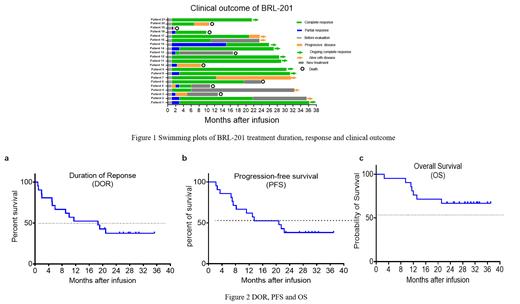BACKGROUND :
CAR-T cell products are manufactured traditionally by using virus, which leads to the potential tumorigenesis risk and makes CAR-T cell therapy expensive and time-consuming. We developed a novel approach to generate non-viral, genome-specific integrated CAR-T cells through CRISPR/Cas9, thereby breaking through both virus usage and random integration simultaneously. Here, we update long term follow up data of trial of non-viral PD1 locus specifically integrated anti-CD19 CAR-T cells (BRL-201) in patients with relapsed/refractory (r/r) Non-Hodgkin's lymphoma (#NCT04213469). Recently, a phase I/II of BRL-201 (#NCT05741359) is ongoing with a large-scale and multi-center design to further evaluate of BRL-201 antitumor activity in lower dose level.
METHODS :
This phase I investigator initiated trial evaluates BRL-201 in adult patients with r/r B-NHL. Adult patients with r/r B-NHL underwent leukapheresis and a lymphodepletion chemotherapy with cyclophosphamide (500mg/m 2, D -3 to -2) and fludarabine (30mg/m 2, D -4 to -2) before BRL-201 infusion. Dose escalation are based on 3+3 escalation rule, including three cohorts: 2×10 6/kg, 4×10 6/kg, 6×10 6/kg. Besides, 3 subjects received non-standard infusion doses at 0.56~0.8 × 10 6/kg. The primary endpoint was the incidence of dose-limiting toxicities (DLT). The secondary endpoint was the proportion of patients achieving an objective response at 3 months as per investigator's assessment. In the phase I/II sponsor initiated clinical trial, we employed 3+3 rule in the escalation phase.
RESULTS:
Between May 3, 2020 and August 10, 2021, 25 patients with r/r B-NHL were enrolled and 21 received BRL-201 with a median age of 56 years (34-70) and a median of 4 (1-9) prior lines of therapy. Among all the treated patients, 17 patients (93.8%) were diagnosed with disease stage III or IV, and 13 patients (81.3%) were assessed with high-intermediate to high risk according to IPI or aaIPI score assessment. Two patients had undergone autologous hematopoietic stem cell transplantation (HSCT) and one patient had a history of primary refractory disease. Of 17 patients with pretreatment tumor samples PD-L1 expression detection, 4 (23.5%) had > 50% PD-L1 expression, 13 (76.5%) had ≤50% PD-L1 expression.
As of May 17, 2023, the median follow- up of investigaor initiated phase I study was 29.0 months (21.5-36.2 m). All of 21 (100%) patients had an objective response to BRL-201 and 18 (85.7%) patients had a complete response (CR) as best response (Fig. 1). 7 patients achieved and maintained CR at data cut-off date, among these, 3 patients had PD-L1 expression > 50%, 1 patient was negative and 3 unknown. The median duration of response(DOR) for all 21 patients was 18.6 months (95%CI:5.1, NA ) (Fig. 2a). The median progression free survival (PFS) was 20.8 (95%CI:8.2, NA) months (Fig. 2b), while the estimated median overall survival (OS) was not reached, 12-month OS rate was 76.2% (95% CI: 60%, 96.8%) (Fig. 2c). No grade 3-4 CRS and ICANS were observed. 14 patients (66.7%) experienced grade 1-2 cytokine release syndrome (CRS) and only one patient received tocilizumab. 4 patients (19.0%) experienced grade 1-2 immune effector cell-associated neurotoxicity syndrome (ICANS). No new AEs/SAEs were observed during the last follow up. In the ongoing phase I study, 1 patient with DLBCL was treated with BRL-201 and no DLT observed during 28 days after infusion at dose of 2×10 5/kg.
CONCLUSIONS :
Over a median follow up of 29 months, BRL-201 was demonstrated durable response with a high median PFS of 20.8 months and 12-month OS rate of 76.2%. The median OS was not reached yet for responding patients, and the safety profile was manageable. More data will be collected to prove the value of clinical usage of BRL-201.
Disclosures
No relevant conflicts of interest to declare.


This feature is available to Subscribers Only
Sign In or Create an Account Close Modal